ASUS P8Z77-V Deluxe Review - Know Your SKU
by Ian Cutress on May 12, 2012 8:45 AM EST- Posted in
- Motherboards
- Asus
- Z77
LAN Speed Test
LAN Speed Test is a freeware program designed for testing the network connection between two PCs on a home network. The speed of the transfer is limited by the lowest common denominator on the network, so if you have gigabit Ethernet capable computers but a 100 Mbit capable router, you are limited to 100 Mbit transfer. Note that this is really a formality – if a network port is rated at 1 Gbps, then chances are that it should hit at least 90+% of this value. The main test here is CPU usage, and how much is offloaded by the controller. For this test, we use LAN Speed Test to transfer 1000 x 1 MB files across a home network with a 1 Gbps lowest common speed to the same machine each time, in a read/write scenario.

Due to a new slight variation in our LAN testing, the LAN Read numbers for our Z77 lineup are void - as soon as we can get time to test the previous boards, we will include the numbers back again. In terms of sequential write testing however, the Deluxe does well on the Realtek NIC.
USB Speed
For this benchmark, we run CrystalDiskMark to determine the ideal sequential read and write speeds for the USB port using our 240 GB OCZ Vertex3 SSD with a SATA 6 Gbps to USB 3.0 converter. Then we transfer a set size of files from the SSD to the USB drive using DiskBench, which monitors the time taken to transfer. The files transferred are a 1.52 GB set of 2867 files across 320 folders – 95% of these files are small typical website files, and the rest (90% of the size) are the videos used in the Sorenson Squeeze test.
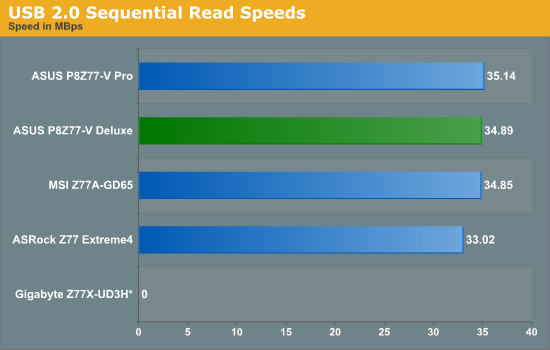
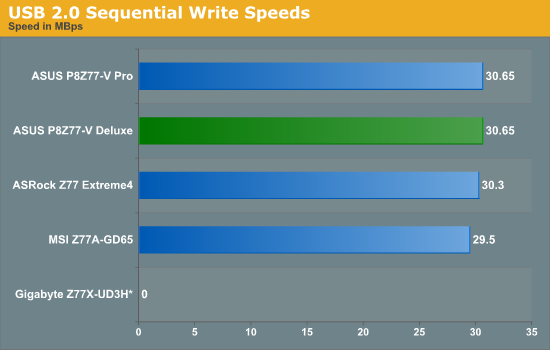
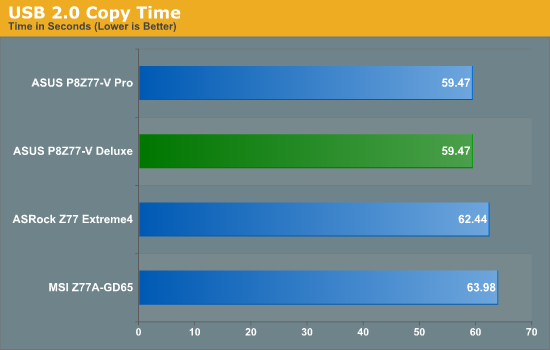
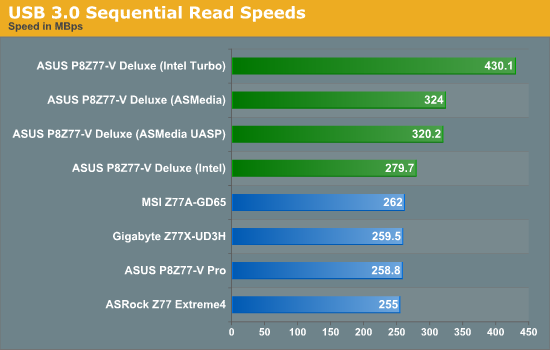

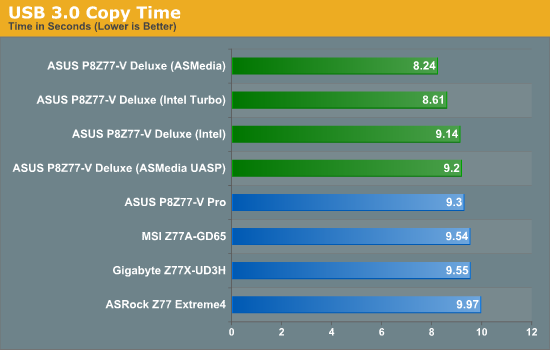
USB results, in particular the USB 3.0 results, are rather impressive - both the ASMedia and Intel controllers out perform the Intel controllers on other boards in our absolute copy test, and even more so when under USB 3.0 Boost modes.
SATA Testing
We also use CrystalDiskMark for SATA port testing on a C300 drive. The sequential test (incompressible data) is run at the 5 x 1000 MB level. This test probes the efficiency of the data delivery system between the chipset and the drive, or in the case of additional SATA ports provided by a third party controller, the efficiency between the controller, the chipset and the drive.
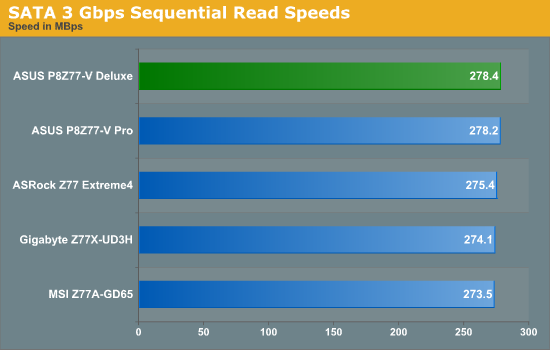

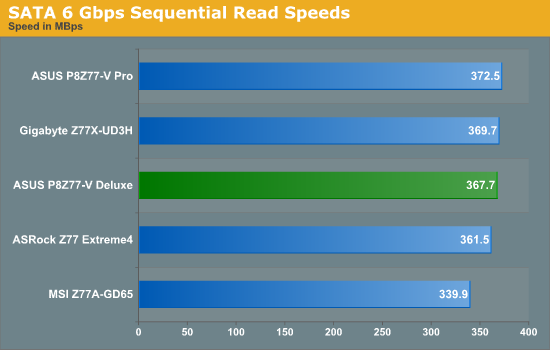
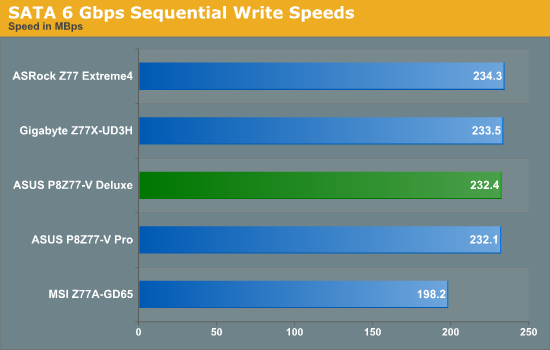
SATA testing on the Deluxe shows no abnormalities.
DPC Latency
Deferred Procedure Call latency is a way in which Windows handles interrupt servicing. In order to wait for a processor to acknowledge the request, the system will queue all interrupt requests by priority. Critical interrupts will be handled as soon as possible, whereas lesser priority requests, such as audio, will be further down the line. So if the audio device requires data, it will have to wait until the request is processed before the buffer is filled. If the device drivers of higher priority components in a system are poorly implemented, this can cause delays in request scheduling and process time, resulting in an empty audio buffer – this leads to characteristic audible pauses, pops and clicks. Having a bigger buffer and correctly implemented system drivers obviously helps in this regard. The DPC latency checker measures how much time is processing DPCs from driver invocation – the lower the value will result in better audio transfer at smaller buffer sizes. Results are measured in microseconds and taken as the peak latency while cycling through a series of short HD videos - under 500 microseconds usually gets the green light, but the lower the better.
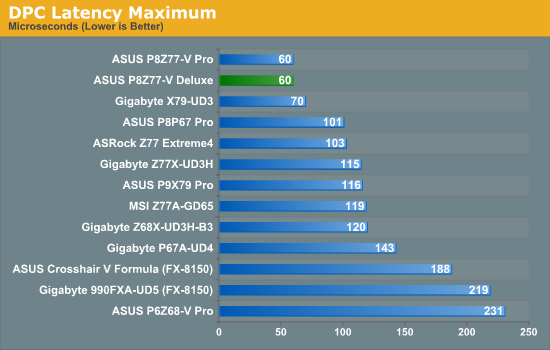
The agressive BIOS settings of the P8Z77-V Pro and Deluxe have helped both of them get the best ever results in our DPC Latency test.










52 Comments
View All Comments
IanCutress - Monday, May 14, 2012 - link
We tested both, as there is two green lines in that graph. Whereas the Realtek seems to win out in pure throughput in our testing, the Intel other has more configurable advantages analogous to Intel NICs.Many thanks for the correction :)
Ian
BrunoLogan - Saturday, May 12, 2012 - link
I'm thinking about building a new machine with the standard version of this board. As we're going to have a new micro architecture next year, I consider pricier boards as throwing money out the door. It will only be useful for Ivy Bridge generation. Next upgrade and you'll have to trash it because Intel will surely change the socket.justaviking - Saturday, May 12, 2012 - link
Based largely on the Z77 motherboard roundup a few days ago (May 7) I ordered the ASUS P8Z77-V Pro to go with a i7-3770k processor. I have one legacy board (a video capture card) that is important to me, so I HAD to have a regular PCI slot. And when the price dropped $25, I said "woo hoo!" and ordered it.The performance against the Deluxe has really made me feel good today. I should have both the CPU and motherboard in a few days.
brickman - Saturday, May 12, 2012 - link
Same here. Quickly grabbed that V-Pro for $210. Although I'll be using an i7 2700KASUS seems to be really standing out with the motherboard features. Integrated wireless without a slot being taken is a big plus. Also WiFI go will be great for my ASUS transformer tablet.
gldg - Saturday, May 12, 2012 - link
I noticed that the memory sticks listed in the test setup are both quad channel. Is that a goofed link or can you put quad channel in the dual channel Z77 chipset?Also, could someone tell me what happens when you put 1.65V sticks in this board? I've seen alot of warnings around using 1.65V kits with Ivy...if I put (for example) 2800 1.65V RAM in, can I set it to 1600 and 1.5V in the BIOS?
KivBlue - Saturday, May 12, 2012 - link
I don't see how 1.65V RAM would be an issue, that's the highest Voltage recommended by Ivy Bridge CPU. It also officially supports up to 1600mhz, but Sandy Bridge only supported up to 1333mhz yet there were no issues with people using 1600mhz RAM with Sandy Bridge. If the mobo supports RAM overclock of 2800 I don't see a problem, but it's either going to not work with Ivy Bridge or won't make much of an actual performance boost.Azethoth - Monday, May 14, 2012 - link
It is not a goofed link. My ASUS P8Z77-V Deluxe has 4x8=32Gb (G.SKILL Trident X Series 16GB (2 x 8GB) 240-Pin DDR3 SDRAM DDR3 2400 (PC3 19200) Desktop Memory Model F3-2400C10D-16GTX).If you read the launch lineup, Asus actually did something special with memory. Instead of serial access they parallelized it which means their timings are tighter than the old scheme and they are getting stable overclocks to 2800. Also, you are not penalized for populating all 4 slots. Their 2800 G.Skill qualified memory was with 4x4 dimms: http://dlcdnet.asus.com/pub/ASUS/mb/LGA1155/P8Z77-...
The Trident X they did that with does not show up on any online store yet which is why I went with 2 sets of the DDR3 2400 kit from newegg.
IanCutress - Monday, May 14, 2012 - link
Hi gldg,There was an error in my test setup. For Ivy I am using F3-19200CL9Q-16GBZMD (4x4 GB kit) and F3-2666C11D-8GTXD (2x4 GB Kit) - first for 16 GB compatibility (that kit is notorious on certain boards) and the second for speed testing.
There should be no issues putting a quad channel kit in a dual channel board. The number of channels is determined by the CPU probing the memory at boot, not the memory telling the system how many channels to run in. Hence why you can run Quad channel kits in X79 with 1-3 sticks for single to tri-channel respectively. It's all mix and match now :)
All the best,
Ian
gldg - Monday, May 14, 2012 - link
Thanks Kiv, Aze and Ian. Re. the voltage, I had glanced at the QVL but I wasn't sure if it was a case of Asus telling me I *could* get those speeds and volts under the right circumstances, versus Intel telling me *should* stay below their official recommended max of 1.5V. It's been a few chipsets since I've built a full enthusiast rig and wasn't sure how everything would behave at default.The quad channel issue is good to know and opens up bunches of more options. Any reason why there's no 32GB kits listed on the QVL at any speed?
Thanks for a great review Ian.
Azethoth - Wednesday, May 16, 2012 - link
Now that you mention it they did not qualify any 8GB dimms.Well, anecdotaly, the kit I linked is running at its rated 2400 clock speed. There is something weird with the bios not automatically running it at high speed but there is a single bios setting to crank it up with.
Maybe it is just a pure cost thing. Not testing 8GB kit saves money and 32GB ran me over $400. On the other hand, if your kit makes the grade it is pure free advertising so memory vendors probably provide them for free. G.Skill will probably clean up this cycle since they got the high score.